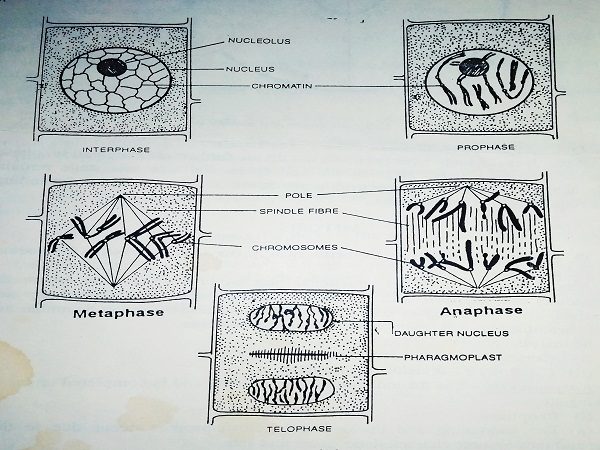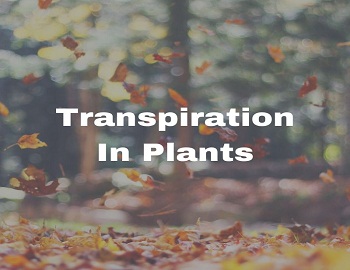Table of Contents
What is Mitosis?
- The process of cell division was observed first of all by the German biologist Walther Flemming and gave it the term mitosis, meaning thread formation.
- Mitosis is an equational process of cell division where the chromosomes are duplicated and are equally distributed both quantitatively and qualitatively into two daughter cells. Daughter cells possess the same number and type of chromosomes and resemble exactly to their parents. Mitosis occurs during the formation of body cells. It is, therefore, also called somatic cell division.
Mitosis Occurrence:
- It occurs in almost all cells during the growth of an embryo.
- Later on, it occurs in some specific regions like skin and bone marrow in animals and meristems in plants.
- The root tip is the best material to study mitosis. Acetocarmine is the stain used for it.
Process of Mitosis:
Mitosis is characterized by certain complicated changes which, for convenience, can be studied under the following stages-

Interphase:
- A cell from the time it is ‘born’ to the time when it starts dividing is called interphase.
- During interphase, a cell is said to be in the resting stage and occupies the longest duration (approximately 95% of the duration of the cell cycle).
The interphase is divided into three phases:
- G1 phase (Gap 1)– G1 phase corresponds to the interval between mitosis and initiation of DNA replication. During the G1 phase, the cell is metabolically active and continuously grows but does not replicate its DNA.
- S phase (Synthesis)– S or synthesis phase marks the period during which DNA synthesis or replication takes place.
- G2 phase (Gap 2)– During the G2 phase, proteins are synthesized in preparation for mitosis while cell growth continues.
Thus, during interphase the chromosomes duplicate into their exact copies.
Karyokinesis:
It is the indirect nuclear division and is completed under the following steps-
Prophase:
- Prophase marks the beginning of cell division.
- It is the longest phase of mitosis.
- The shortening and thickening of chromosomes occur due to their coiling and they assume characteristic shape and size.
- Nuclear volume gradually increases.
- The chromosome having undergone longitudinal splitting (during S phase of interphase) start condensing and each chromosome is formed of two chromatids held up at centromere.
- A spindle consisting of fibers starts developing between the opposite poles of a cell. Microtubule, the proteinaceous component of the cell cytoplasm helps in the formation of mitotic spindle.
- The disappearance of the nuclear membrane and nucleolus occurs in the cytoplasm. Golgi complex and Endoplasmic reticulum fragments are not clearly observed.
- Note: In animal cells, the centrioles divide and each centriole forms an aster. The aster moves towards the opposite poles and initiates the formation of the spindle.
Metaphase:
- It is short and simple. Spindle appears with the disappearance of the nuclear envelope and nucleolus and it consists of astral rays, continuous fibres, and tactile fibres.
- Chromosomes arrange themselves at the equatorial plate through microtubules to both poles and form a metaphase plate which is at right angles to the spindle.
- The chromosomes are joined with the spindle fibres microtubules exactly in the equatorial plate by their own kinetochores of centromere and their arms face towards the poles.
Anaphase:
- During anaphase, the centromere of each chromosome splits, thus, separating the two sister chromatids, both of which are now called daughter chromosomes.
- The daughter chromatids (chromosomes) move towards the opposite poles where the centromere is seen at its leading edge with the arms of the chromosomes trailing behind. The movement is brought about by the contraction of spindle fibres.
- During their poleward migration, the centromeres remain foremost so that the chromosomes characteristically appear U, V, or J-shaped.
Telophase:
- The chromatids reach the poles of the spindle and form two groups.
- Chromosomes undergo uncoiling and decondensation, thereby, they become thin and long.
- The spindle starts dissolving and the nuclear envelope, nucleolus, Golgi complex, and Endoplasmic reticulum regenerate.
- The two nuclei are formed at the two poles of a cell.
Cytokinesis:
- It immediately follows karyokinesis.
- Cytokinesis is the process of cleavage and separation of cytoplasm. It is the time during which cytoplasmic components and organelles are distributed between the daughter cells.
- In plant cells, a cell plate of dense cisternae (phragmoplast) is laid down at the equatorial plate. It grows centrifugally (extends laterally) towards the plasma membrane until it divides the cell into two parts. The space in between the two membranes of cisternae is filled by the deposition of pectates of calcium and magnesium to become middle lamella.
- In animal cells, cytokinesis occurs by an invagination of the cell membrane almost in the middle of the cell. The furrow gradually deepens and ultimately divides the cell into two parts.
- In some organisms, karyokinesis is not followed by cytokinesis as a result of which multinucleate condition arises which is called a syncytium. Example- liquid endosperm in coconut.
Significance of Mitosis:
- It is a means of growth and development in an organism.
- It helps in healing wounds and replacing the old and damaged tissues by the new ones. The cells of the upper layer of the epidermis (skin), cells of the lining of the gut, and blood cells are being constantly replaced and regeneration of damaged parts (example- the tail of a lizard, arms of starfish).
- It helps the cell in maintaining proper size.
- It is an equatorial division and plays a vital role in reproduction and maintains the number of chromosomes constant from generation to generation.
- The daughter cells produced by mitosis remain identical to their parents in a genetic constitution.
- It helps in vegetative propagation and asexual reproduction of organisms. In unicellular organisms, every mitotic division leads to asexual reproduction during which two or more individuals arise from the mother cell.
- In genetic engineering and biotechnology, tissues are grown by mitosis (i.e. in tissue culture).
- If mitosis uncontrolled, it may cause a tumour or cancerous growth.









Comments (No)